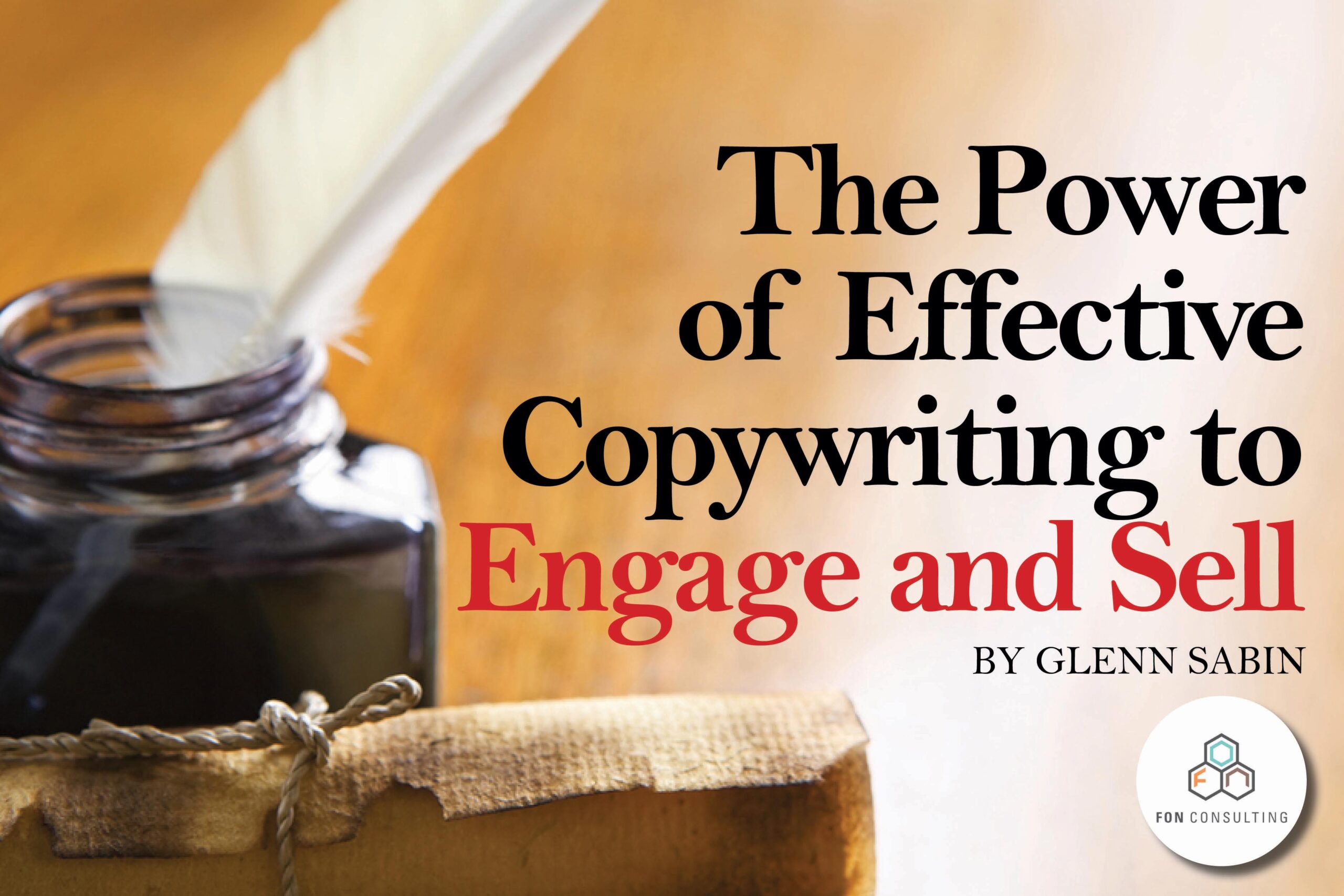The Power of Effective Copywriting to Engage and Sell
By Glenn Sabin

Is your own copywriting hurting your integrative health brand?
I write quite a bit: for this blog and my personal blog. I regularly craft comprehensive assessments and business development strategy documents for clients, and I’ve authored a memoir.
Everyone looking to be a thought leader (aka key opinion leader or KOL) in the integrative health field—or wanting to be well-positioned within their local community—should write. I discuss this here and here.
However, none of the above falls under ‘copywriting or ‘messaging’. From my perspective as a writer, copywriting and tight messaging are the most challenging types of writing.
Strong copywriting requires exceptional skill, the result of tons of practice by those who have the gift of deep insight. Writing sharp, highly engaging copy is a singular art form. It involves the expertise to carry a unique, even tone, which targets an identified buyer persona or avatar.
Stellar copywriting essentially exhales the voice of your brand.
I hired a seasoned copywriter for my personal brand website. Did I do some tweaking and suggest some changes after the original had been drafted? Absolutely. My point is, I hired an expert; I didn’t attempt to take the first pass, even though the topic is my personal story with incurable cancer—a subject I have written on extensively.
Too Close to the Woods to See the Trees
You may pen exceptional prose, do a bang-up job crafting business reports, or churn out scientific papers with ease—but are you the best person to write the content for your website, collateral, advertisements, or any number of key copy and messaging areas organization-wide? Or even for your small business?
You are skilled at what you do. You know your business inside out. But you may be too close to the woods to see the trees—thus unable to craft copy that best positions your brand to engage and ‘sell’.
If you suspect your copy falls flat or is otherwise subpar—ex. little traffic on your site, quick exits, high bounce rates, no feedback (or negative feedback)—and you do not have strong in-house resources to develop copy, then you need to look outside for this vital support.
Copywriting is Different from Articles and Blog Posts
Don’t confuse ‘copywriting’ and ‘messaging’ with articles and other posts that should comprise your content strategy. You need the latter to effectively grow your list and engage prospects and current clients.
Think of it like this: copywriting and messaging is ‘static’, while articles, posts and other media-making is ‘fluid’. Follow?
Enjoying this article? Subscribe and get our latest, delivered straight to your inbox.
The catalyst that converts prospects to customers is embedded in the DNA of effective copywriting. Specifically I am talking about the static content that fills the various core navigation areas of your website:
- Homepage
- About us
- Services
- Products
- Start here
- Client/patient stories (as testimonials)
- Contact
In addition to the static textual areas of your website, there are myriad additional executions (digital and print) that span your entire enterprise or organization. Think banners, business cards, and brochures.
These collateral items, product pages, promotions, and advertisements all require consistent on-brand copy that matches your unique tone. Neglect one area and it will let down the entire messaging effort. Well-honed, tight, profoundly-compelling messaging, spread across entire campaigns, converts readers to buyers, be they members, students, patients, or clients.
The Art of Effective Copy Creation
Seasoned, top-quality copywriters will rarely have the expertise in the particular area for which they are hired to craft content—but this certainly does happen. Their proficiency lies in the ability to interview subject(s), research your industry, and, if necessary, speak with clients, customers, or even prospects to build subject matter. Copywriting pros often put themselves in various headspaces and role-play a prospective customer.
Have you ever paid attention to pithy, descriptive, and lively copy used across Amazon.com, or the dynamic copy and key messaging used on deal sites like Living Social or Groupon? What about that annual catalog you receive from Nordstrom or H&M? This stuff is typically very well executed.
Subpar Copy Moves Few to Action
The worst person to pen your static content and messaging may be you. You are most likely more helpful to the process by being interviewed, and sharing the why of what you do; a position from which you can help shape and inform your company’s brand positioning statement. You may be most effective at tweaking and optimizing copy that has already taken solid shape.
Six Seconds to Engage
This time-frame keeps narrowing as attention spans shrink due to a never-ending deluge of free content.
The core purpose of copywriting and messaging, especially for a website, but also across all media—digital and print—is to communicate in six seconds or less and bring the reader down a sales funnel to the next block of copy; or to motivate the reader to take a specific action, like clicking an explainer video, or to ‘learn more’, purchase a product, or to book an appointment.
If your integrative or functional medicine brand is riddled with heavy, dense prose, with no or little vibrancy or an uneven tone, you have a problem. If your copy and messaging has been written piecemeal, and by committee, over time, then you have a problem.
Reevaluate How You Communicate
It is never too late to change course. You have a terrific opportunity to revisit and recast your key copy areas—across your enterprise—to elevate and bring consistency to your brand positioning (and to make you more findable).
At the same time you will have the opportunity to improve your on-page search engine optimization, across all digital content areas, through keyword research. A copywriter, informed by your business, utilizes findings—phrases and keywords—to optimize each page, and in a semantic manner that Google rewards.
Ask a few people, whose opinion you respect, about how your copy communicates and engages. These folks do not need to be from the integrative health space. In fact, it’s best if they aren’t.
Have a few reviewers provide honest feedback on how your copy connects with them. How quickly do they understand what is being offered? Do they immediately comprehend the potential benefit to them? Is it apparent why they should care? Are they able to immediately understand, and effortlessly take, the next steps in your process? Start there.
Takeaways
- Six seconds to connection. Make time count with brilliant composition. Dense, long, disorganized will kill your ability to convey the attributes of your product or service.
- Make every page count. All copy and messaging across your organization must be consistently crafted with your unique brand voice to engage prospects and convert to sales.
- Invest in a pro. Copywriting is a learned skill; a specialization. You may be the worst person, as a leader within your organization, to create this content.
- Do keyword research to determine keywords and phrases you need to rank high for. Then have the copywriter optimize each digital page, using a semantic approach, as part of the copywriting process.
- Engage some ‘friendlies’ to provide candid feedback on how your website (and non-digital material) communicates and bring them down through a process of learning what you have to offer, and why they should care.
In Summary
Words and language matter. When it comes to copywriting and crafting messaging for your integrative or functional medicine brand, every word ‘not in the copy’ counts.
About FON
FON is a leading integrative health and medicine business development and strategy consulting firm. FON specializes in custom solutions for growing patient volume, developing programs, and increasing product sales. Our practical business models are driven by innovative marketing, clear messaging, and customer engagement via branded storytelling.
Contact us today to schedule a complimentary 30-minute consultation to discuss your business development or personal brand needs.

Read Glenn’s story.





















